标签:算法 tin adc 次数 ber ISE elements 程序 提示
编写一个程序,通过已填充的空格来解决数独问题。
一个数独的解法需遵循如下规则:
1-9 在每一行只能出现一次。1-9 在每一列只能出现一次。1-9 在每一个以粗实线分隔的 3x3 宫内只能出现一次。空白格用 ‘.‘ 表示。

一个数独。

答案被标成红色。
Note:
1-9 和字符 ‘.‘ 。9x9 形式的。首先的想法是通过蛮力法来生成所有可能用1 到 9填充空白格的解,
并且检查合法从而保留解。这意味着共有 个操作需要进行。
其中 是可行的数字个数, 是需要填充的格子数目。
因此我们必须考虑进一步优化。
使用的概念
了解两个编程概念会对接下来的分析有帮助。
第一个叫做 约束编程。
基本的意思是在放置每个数字时都设置约束。在数独上放置一个数字后立即
排除当前 行, 列 和 子方块 对该数字的使用。这会传播 约束条件 并有利于减少需要考虑组合的个数。

第二个叫做 回溯。
让我们想象一下已经成功放置了几个数字
在数独上。
但是该组合不是最优的并且不能继续放置数字了。该怎么办? 回溯。
意思是回退,来改变之前放置的数字并且继续尝试。如果还是不行,再次 回溯。

如何枚举子方块
一种枚举子方块的提示是:
使用 方块索引= (行 / 3) * 3 + 列 / 3
其中 / 表示整数除法。

算法
现在准备好写回溯函数了
backtrack(row = 0, col = 0)。
从最左上角的方格开始 row = 0, col = 0。直到到达一个空方格。
从1 到 9 迭代循环数组,尝试放置数字 d 进入 (row, col) 的格子。
如果数字 d 还没有出现在当前行,列和子方块中:
d 放入 (row, col) 格子中。d 已经出现在当前行,列和子方块中。row == 8, col == 8 :
(row, col) 移除。代码
class Solution {
// box size
int n = 3;
// row size
int N = n * n;
int [][] rows = new int[N][N + 1];
int [][] columns = new int[N][N + 1];
int [][] boxes = new int[N][N + 1];
char[][] board;
boolean sudokuSolved = false;
public boolean couldPlace(int d, int row, int col) {
/*
Check if one could place a number d in (row, col) cell
*/
int idx = (row / n ) * n + col / n;
return rows[row][d] + columns[col][d] + boxes[idx][d] == 0;
}
public void placeNumber(int d, int row, int col) {
/*
Place a number d in (row, col) cell
*/
int idx = (row / n ) * n + col / n;
rows[row][d]++;
columns[col][d]++;
boxes[idx][d]++;
board[row][col] = (<span class="hljs-keyword">char</span>)(d + <span class="hljs-string">‘0‘</span>);
}
public void removeNumber(int d, int row, int col) {
/*
Remove a number which didn‘t lead to a solution
*/
int idx = (row / n ) * n + col / n;
rows[row][d]--;
columns[col][d]--;
boxes[idx][d]--;
board[row][col] = ‘.‘;
}
public void placeNextNumbers(int row, int col) {
/*
Call backtrack function in recursion
to continue to place numbers
till the moment we have a solution
*/
// if we‘re in the last cell
// that means we have the solution
if ((col == N - 1) && (row == N - 1)) {
sudokuSolved = true;
}
// if not yet
else {
// if we‘re in the end of the row
// go to the next row
if (col == N - 1) backtrack(row + 1, 0);
// go to the next column
else backtrack(row, col + 1);
}
}
public void backtrack(int row, int col) {
/*
Backtracking
*/
// if the cell is empty
if (board[row][col] == ‘.‘) {
// iterate over all numbers from 1 to 9
for (int d = 1; d < 10; d++) {
if (couldPlace(d, row, col)) {
placeNumber(d, row, col);
placeNextNumbers(row, col);
// if sudoku is solved, there is no need to backtrack
// since the single unique solution is promised
if (!sudokuSolved) removeNumber(d, row, col);
}
}
}
else placeNextNumbers(row, col);
}
public void solveSudoku(char[][] board) {
this.board = board;
<span class="hljs-comment">// init rows, columns and boxes</span>
<span class="hljs-keyword">for</span> (<span class="hljs-keyword">int</span> i = <span class="hljs-number">0</span>; i < N; i++) {
<span class="hljs-keyword">for</span> (<span class="hljs-keyword">int</span> j = <span class="hljs-number">0</span>; j < N; j++) {
<span class="hljs-keyword">char</span> num = board[i][j];
<span class="hljs-keyword">if</span> (num != <span class="hljs-string">‘.‘</span>) {
<span class="hljs-keyword">int</span> d = Character.getNumericValue(num);
placeNumber(d, i, j);
}
}
}
backtrack(<span class="hljs-number">0</span>, <span class="hljs-number">0</span>);
}
}
from collections import defaultdict
class Solution:
def solveSudoku(self, board):
"""
:type board: List[List[str]]
:rtype: void Do not return anything, modify board in-place instead.
"""
def could_place(d, row, col):
"""
Check if one could place a number d in (row, col) cell
"""
return not (d in rows[row] or d in columns[col] or
d in boxes[box_index(row, col)])
<span class="hljs-function"><span class="hljs-keyword">def</span> <span class="hljs-title">place_number</span><span class="hljs-params">(d, row, col)</span>:</span>
<span class="hljs-string">"""
Place a number d in (row, col) cell
"""</span>
rows[row][d] += <span class="hljs-number">1</span>
columns[col][d] += <span class="hljs-number">1</span>
boxes[box_index(row, col)][d] += <span class="hljs-number">1</span>
board[row][col] = str(d)
<span class="hljs-function"><span class="hljs-keyword">def</span> <span class="hljs-title">remove_number</span><span class="hljs-params">(d, row, col)</span>:</span>
<span class="hljs-string">"""
Remove a number which didn‘t lead
to a solution
"""</span>
<span class="hljs-keyword">del</span> rows[row][d]
<span class="hljs-keyword">del</span> columns[col][d]
<span class="hljs-keyword">del</span> boxes[box_index(row, col)][d]
board[row][col] = <span class="hljs-string">‘.‘</span>
<span class="hljs-function"><span class="hljs-keyword">def</span> <span class="hljs-title">place_next_numbers</span><span class="hljs-params">(row, col)</span>:</span>
<span class="hljs-string">"""
Call backtrack function in recursion
to continue to place numbers
till the moment we have a solution
"""</span>
<span class="hljs-comment"># if we‘re in the last cell</span>
<span class="hljs-comment"># that means we have the solution</span>
<span class="hljs-keyword">if</span> col == N - <span class="hljs-number">1</span> <span class="hljs-keyword">and</span> row == N - <span class="hljs-number">1</span>:
<span class="hljs-keyword">nonlocal</span> sudoku_solved
sudoku_solved = <span class="hljs-literal">True</span>
<span class="hljs-comment">#if not yet </span>
<span class="hljs-keyword">else</span>:
<span class="hljs-comment"># if we‘re in the end of the row</span>
<span class="hljs-comment"># go to the next row</span>
<span class="hljs-keyword">if</span> col == N - <span class="hljs-number">1</span>:
backtrack(row + <span class="hljs-number">1</span>, <span class="hljs-number">0</span>)
<span class="hljs-comment"># go to the next column</span>
<span class="hljs-keyword">else</span>:
backtrack(row, col + <span class="hljs-number">1</span>)
<span class="hljs-function"><span class="hljs-keyword">def</span> <span class="hljs-title">backtrack</span><span class="hljs-params">(row = <span class="hljs-number">0</span>, col = <span class="hljs-number">0</span>)</span>:</span>
<span class="hljs-string">"""
Backtracking
"""</span>
<span class="hljs-comment"># if the cell is empty</span>
<span class="hljs-keyword">if</span> board[row][col] == <span class="hljs-string">‘.‘</span>:
<span class="hljs-comment"># iterate over all numbers from 1 to 9</span>
<span class="hljs-keyword">for</span> d <span class="hljs-keyword">in</span> range(<span class="hljs-number">1</span>, <span class="hljs-number">10</span>):
<span class="hljs-keyword">if</span> could_place(d, row, col):
place_number(d, row, col)
place_next_numbers(row, col)
<span class="hljs-comment"># if sudoku is solved, there is no need to backtrack</span>
<span class="hljs-comment"># since the single unique solution is promised</span>
<span class="hljs-keyword">if</span> <span class="hljs-keyword">not</span> sudoku_solved:
remove_number(d, row, col)
<span class="hljs-keyword">else</span>:
place_next_numbers(row, col)
<span class="hljs-comment"># box size</span>
n = <span class="hljs-number">3</span>
<span class="hljs-comment"># row size</span>
N = n * n
<span class="hljs-comment"># lambda function to compute box index</span>
box_index = <span class="hljs-keyword">lambda</span> row, col: (row // n ) * n + col // n
<span class="hljs-comment"># init rows, columns and boxes</span>
rows = [defaultdict(int) <span class="hljs-keyword">for</span> i <span class="hljs-keyword">in</span> range(N)]
columns = [defaultdict(int) <span class="hljs-keyword">for</span> i <span class="hljs-keyword">in</span> range(N)]
boxes = [defaultdict(int) <span class="hljs-keyword">for</span> i <span class="hljs-keyword">in</span> range(N)]
<span class="hljs-keyword">for</span> i <span class="hljs-keyword">in</span> range(N):
<span class="hljs-keyword">for</span> j <span class="hljs-keyword">in</span> range(N):
<span class="hljs-keyword">if</span> board[i][j] != <span class="hljs-string">‘.‘</span>:
d = int(board[i][j])
place_number(d, i, j)
sudoku_solved = <span class="hljs-literal">False</span>
backtrack()
复杂性分析
这里的时间复杂性是常数由于数独的大小是固定的,因此没有 N 变量来衡量。
但是我们可以计算需要操作的次数: 。
我们考虑一行,即不多于 个格子需要填。
第一个格子的数字不会多于 种情况,
两个格子不会多于 种情况,
三个格子不会多于 种情况等等。
总之一行可能的情况不会多于 种可能,
所有行不会多于 种情况。比较一下:
空间复杂性:数独大小固定,空间用来存储数独,行,列和子方块的结构,每个有 81 个元素。
https://www.jianshu.com/p/c6d055a2ab64
标签:算法 tin adc 次数 ber ISE elements 程序 提示
原文地址:https://www.cnblogs.com/leetcodetijie/p/13200373.html